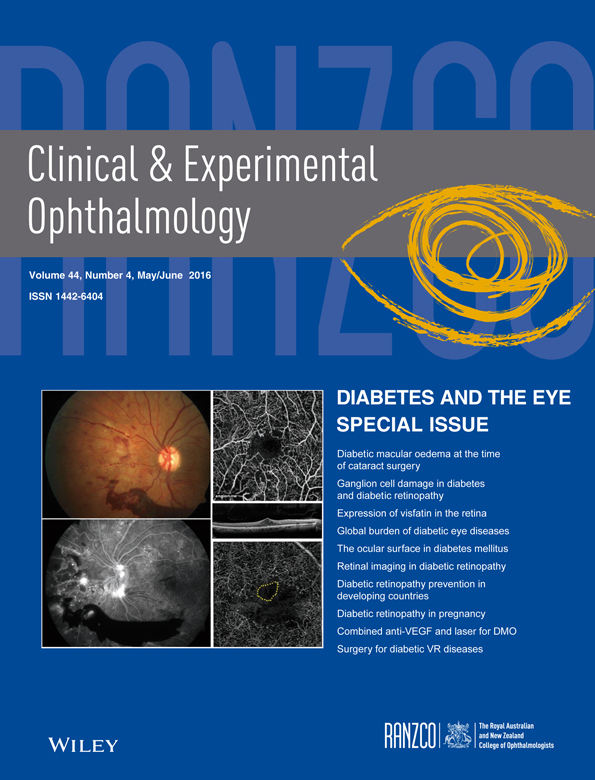Continuing professional development
RANZCO Fellows can claim continuing professional development points by reading the following two articles which appear in this issue and answering the five questions. One point is awarded for each set of five questions answered. Please remember to claim your points.
- Which of the following is NOT associated with advanced diabetic retinopathy (DR) patients?
- There is widespread systemic macro-vascular and micro-vascular abnormalities
- They require either general anaesthesia or monitored local anaesthesia during vitrectomy
- Five-year survival rate for diabetic patients undergoing vitrectomy is less than 50%
- Risk of potential haemorrhage for patients on anti-platelet agents or anti-coagulants undergoing diabetic vitrectomy is not fully established
- Which of the following is NOT a reason for retaining the crystalline lens?
- Lens is an effective barrier against diffusion of VEGF
- Combined surgery carries the potential risk to worsen macular oedema
- The incidence of post-vitrectomy cataract is very low
- Combined surgery increases the risk of more severe postoperative inflammation
- Which of the following optical coherence tomography features is NOT a predictor for visual improvement after vitrectomy?
- Diffuse macular thickening
- Loss of foveal depression and diffuse retinal thinning
- External limiting membrane integrity
- Defect in cone outer segment tips line
- Internal limiting membrane wrinkling
- Which of the following is true regarding preoperative intravitreal injection of anti-VEGF as an adjunct to diabetic vitrectomy?
- The dose of anti-VEGF used is usually higher than normal
- Improves the visual outcomes after vitrectomy for vitreous haemorrhage at 12 months
- There is no difference in the incidence of recurrent vitreous haemorrhage
- Anti-VEGF therapy should be ideally given the day before surgery
- Regarding rhegmatogenous retinal detachment occurring after diabetic vitrectomy, which of the following is false?
- The incidence of rhegmatogenous retinal detachment is not very common
- Most of the retinal breaks are iatrogenic and located posteriorly along the fibrovascular proliferations
- Anterior proliferative vitreoretinopathy develops early in these patients
- Visual prognosis is poor
- Which of the following statements is true? In Australian pregnancies…
- Type 2 diabetes is more common than Type 1
- Type 1 diabetes is more common than Type 2
- Type 1 and Type 2 diabetes are approximately equal
- True or False: Australia's rate of gestational diabetes is higher than the global average.
- When should the first ophthalmic examination take place for a pregnant woman with pre-existing diabetes?
- In the first trimester
- In the second trimester
- Depends on her pre-pregnancy level of retinopathy
- In the third trimester
- Choose the correct statement:
- Laser treatment for proliferative DR may be reasonably delayed during pregnancy
- Laser treatment for diabetic macular oedema may be reasonably delayed during pregnancy
- Any laser treatment should occur earlier in pregnancy
- Any laser treatment should be delayed during pregnancy
- Which of the following is not a risk factor for DR progression during pregnancy?
- Parity
- Hypertension
- Duration of diabetes
- Baseline level of DR
Answers to questions published in previous issue
- Q: What proportion of glaucoma patients have their peak intraocular pressure measurement outside of office hours?
- 0%
- 10%
- 50%
- 75%
- 100%
- A: (d)
- Q: Application of Ibopamine 2% eye-drops causes:
- Miosis and a reduction in aqueous production
- Miosis and an increase in aqueous production
- Mydriasis and an increase in aqueous production
- Mydriasis and a reduction in aqueous production
- None of the above
- A: (c) Mydriasis and an increase in aqueous production
- Q: By what amount must intraocular pressure rise after Ibopamine application, in order for the challenge test to be declared positive?
- Greater than 1 mmHg
- Greater than 2 mmHg
- Greater than 3 mmHg
- Greater than 4 mmHg
- Greater than 5 mmHg
- A: (c) Greater than 3 mmHg
- Q: Prior to surgery, what proportion of rapidly progressing glaucoma patients exhibited a positive Ibopamine challenge?
- 0%
- 10%
- 50%
- 75%
- 100%
- A: (e)
- Q: Following surgery, what proportion of rapidly progressing glaucoma patients, who underwent trabeculectomy surgery, exhibited a positive Ibopamine challenge?
- 0%
- 10%
- 50%
- 75%
- 100%
- A: (a)
- Q: What is the main risk factor for Acanthamoeba keratitis?
- A: Contact lens wear
- Q: What are the two stages in the Acanthamoeba life cycle?
- A: Cyst and trophozoite
- Q: Name one of the agents used most commonly as monotherapy in the treatment of Acanthamoeba keratitis:
- A: Polyhexamethylene biguanide (PHMB) or chlorhexidine
- Q: The lowest concentration of antiseptic agent that results in no excystment and growth of trophozoites is called:
- A: Minimal cysticidal concentration
- Q: In this study, ultraviolet A was able to enhance the cysticidal effect in vitro of:
- PHMB alone
- Chlorhexidine alone
- Both PHMB and chlorhexidine
- Neither PHMB nor chlorhexidine
- A: (d)




